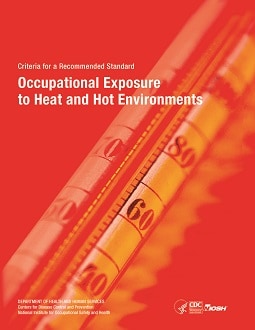Criteria for a Recommended Standard: Occupational Exposure to Heat and Hot Environments
February 2016
DHHS (NIOSH) Publication Number 2016-106

Occupational exposure to heat can result in injuries, disease, reduced productivity, and death. To address this hazard, the National Institute for Occupational Safety and Health (NIOSH) has evaluated the scientific data on heat stress and hot environments and has updated the Criteria for a Recommended Standard: Occupational Exposure to Hot Environments. This document was last updated in 1986, and in recent years, including during the Deepwater Horizon oil spill response of 2010, questions were raised regarding the need for revision to reflect recent research and findings. This revision includes additional information about the physiological changes that result from heat stress; updated information from relevant studies, such as those on caffeine use; evidence to redefine heat stroke and associated symptoms; and updated information on physiological monitoring and personal protective equipment and clothing that can be used to control heat stress.
In 2024, the CDC created a new webpage on Heat and Medications – Guidance for Clinicians. The new guidance uses the latest literature and scientific evidence to build onto the medical knowledge related to medication and heat interactions. This webpage provides a more current update of the 2016 criteria document’s Table 4-2. Drugs implicated in intolerance to heat. As new medications and research become available, it is anticipated that the webpage will be periodically updated.
Occupational Exposure to Heat and Hot Environments [PDF – 3.6 MB]
- Other NIOSH Resources: Heat Stress
